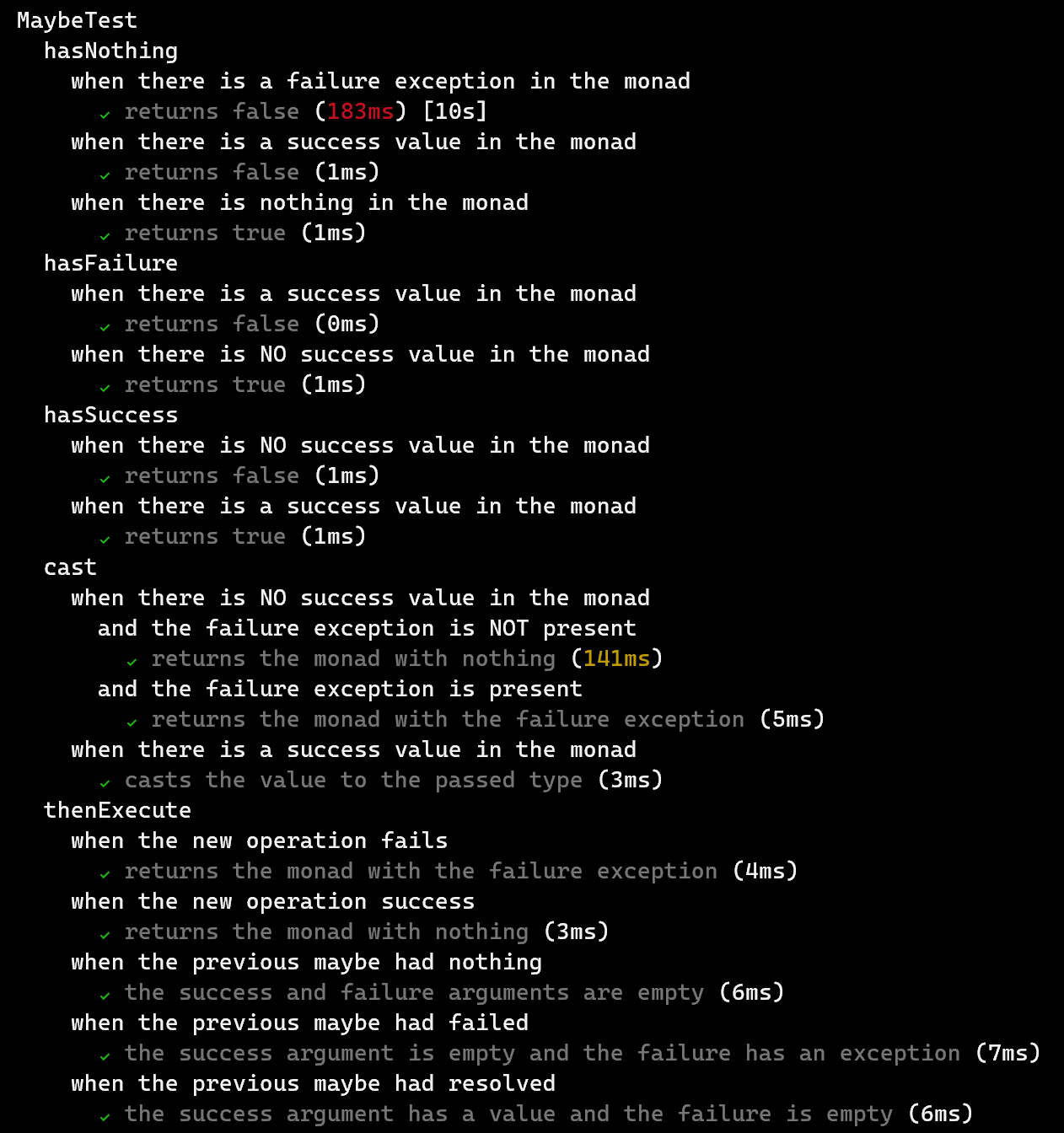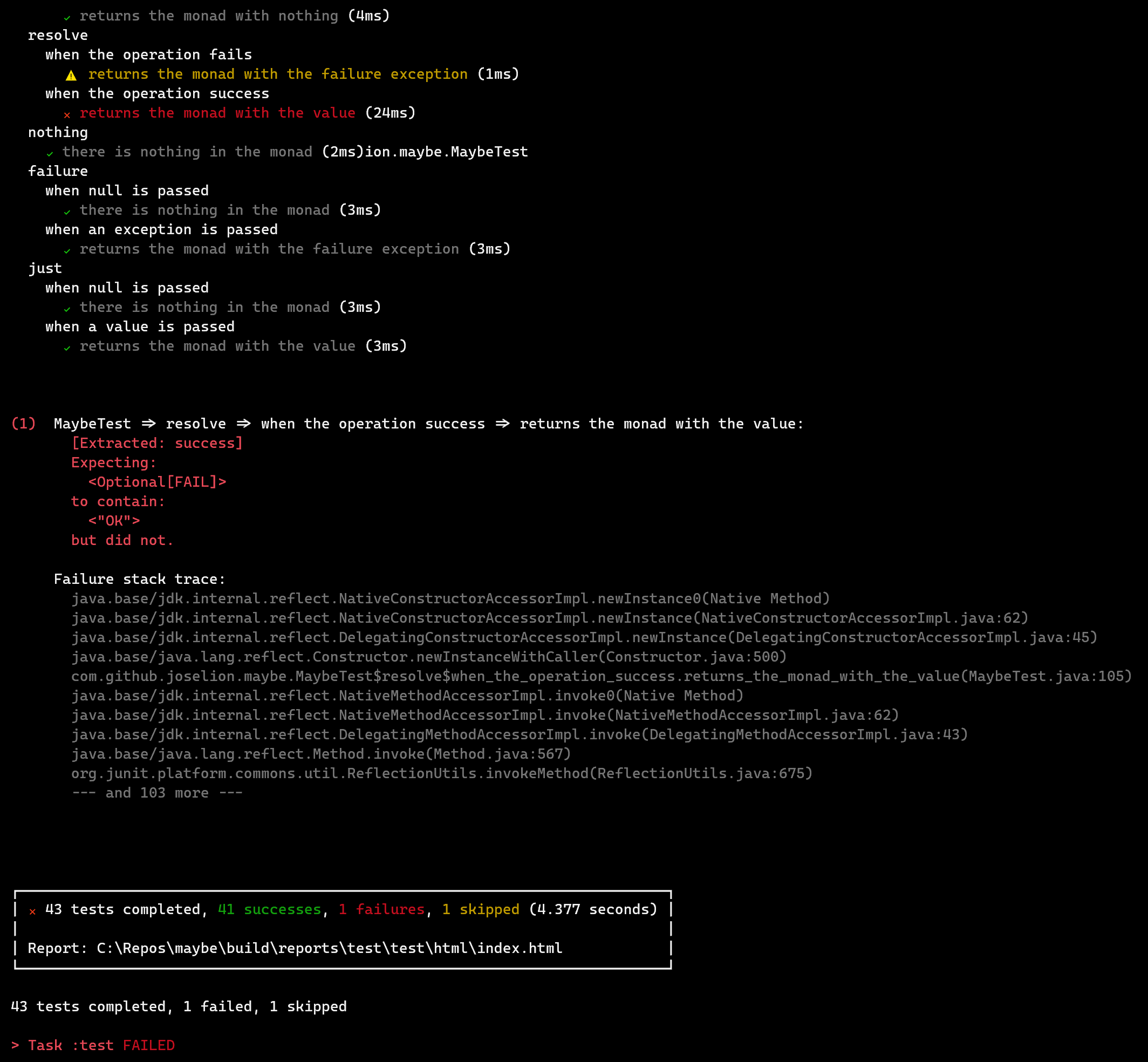Pretty Jupiter
Why?
JUnit 5 brings to us the @Nested annotation feature, which allows the test writer to group tests with similar conditions (initializations, relationships, etc.), and lets us add some BDD love to our test suites. This works great until we run the test suite with Gradle’s test task. Even if we change the testLogging closure on our build script to log more information and events about the tests, we’ll end up with some not-very-friendly to read logs.
This plugin intends to solve that by grouping test logs and presenting them in a more readable, understandable and prettier way. Moving failure traces to the end so they could be tackled more easily and finishing with a pretty summary. Durations, their color threshold, and failure traces can be configured using the prettyJupiter extension.
Usage
⚠️ BREAKING CHANGES ⚠️
Due to changes on GitHub, and by consequence Gradle and Maven, it’s no longer allowed to use
com.githubas a valid group ID prefix. That being said, from version v2.0.0 of the plugin the ID is nowio.github.joselion.pretty-jupiter. If you want to use a version prior to v2.0.0 you can still find it undercom.github.joselion.pretty-jupiter, but keep in mind that theio.githubprefixed ID does not have any v1.x.x version available.
Important: For better results, make sure your system (or the JVM) uses UTF-8 encoding. This can be done in many ways, but a simple one could be to add the JAVA_TOOL_OPTIONS environment variable. This could be specially helpful for Windows users.
JAVA_TOOL_OPTIONS="-Dfile.encoding=UTF8"
Using the plugins DSL:
Groovy
````groovy plugins { id 'io.github.joselion.pretty-jupiter' version 'x.x.x' } ````Kotlin
```kotlin plugins { id("io.github.joselion.pretty-jupiter") version "x.x.x" } ```Using legacy plugin application:
Groovy
```groovy buildscript { repositories { maven { url 'https://plugins.gradle.org/m2/' } } dependencies { classpath 'io.github.joselion.pretty-jupiter:pretty-jupiter:x.x.x' } } apply plugin: 'io.github.joselion.pretty-jupiter' ```Kotlin
```kotlin buildscript { repositories { url = uri("https://plugins.gradle.org/m2/") } dependencies { classpath("gradle.plugin.io.github.joselion.pretty-jupiter:pretty-jupiter:x.x.x") } } apply(plugin = "io.github.joselion.pretty-jupiter") ```Plain output
You may need the output to be plain (colorless and with text-based icons) for example, for logging to a file or for a CI environment. This is possible by setting the environment variable TERM=dumb before running your test command.
Keep in mind that using
--console=plainwill not work at the moment as checking for that flag is not supported by Gradle (check this gradle issue for details).
Extension properties
The plugin can be customized adding a prettyJupiter closure to your build.gradle file and changing the following properties:
| Property | Default | Description |
|---|---|---|
| duration | - | Closure to configure the test durations logged |
| duration.enabled | true |
If true, shows each test execution duration |
| duration.threshold | 200 |
Time threshold in milliseconds. If the test duration is >= than this value, it’ll be colored RED, if it’s >= than half of this value, it’ll be YELLOW, otherwise it’ll be white. |
| duration.customThreshold | empty map | Map that contains task name as a key and its custom threshold as a value. When customThreshold is present and contains running task, duration.threshold is overriden |
| failure | - | Closure to configure the test failures logged |
| failure.maxMessageLines | 15 |
The number of lines of the exception message to display. Note that some exception messages may include some stack trace on it |
| failure.maxTraceLines | 15 |
The number of lines of the exception stack trace to display |
Complete example
Groovy
```groovy prettyJupiter { duration { enabled = true threshold = 75 customThreshold = [test : 100, integrationTest : 150] } failure { maxMessageLines = 15 maxTraceLines = 10 } } ```Kotlin
```kotlin prettyJupiter { duration { enabled.set(true) threshold.set(75) customThreshold.put("test", 100) customThreshold.put("integrationTest", 10000) } failure { maxMessageLines.set(15) maxTraceLines.set(10) } } ```Illustrations
Before
Adding the following to build.gradle file:
Groovy
```groovy test { useJUnitPlatform() testLogging { exceptionFormat 'short' events 'started', 'skipped', 'failed' } } ```Kotlin
```kotlin import org.gradle.api.tasks.testing.logging.TestExceptionFormat.SHORT import org.gradle.api.tasks.testing.logging.TestLogEvent.FAILED import org.gradle.api.tasks.testing.logging.TestLogEvent.SKIPPED import org.gradle.api.tasks.testing.logging.TestLogEvent.STARTED tasks { test { useJUnitPlatform() testLogging { exceptionFormat = SHORT events = setOf(STARTED, SKIPPED, FAILED) } } } ```
With pretty-jupiter plugin applied
We only need Junit 5 configuration in build.gradle(.kts) file:
Groovy
```groovy test { useJUnitPlatform() } ```Kotlin
```kotlin tasks { test { useJUnitPlatform() } } ```

Want to add further customizations?
Please create an issue describing your request, feature or bug. I’ll try to look into it as soon as possible 🙂
Contribution
Contributions are very welcome! To do so, please fork this repository and open a Pull Request to the master branch.
To debug this plugin with help of another gradle project add to external project:
settings.gradle
```groovy pluginManagement { includeBuild '../pretty-jupiter/' } ```settings.gradle.kts
```kotlin pluginManagement { includeBuild("../pretty-jupiter/") } ```Then run your project from command line:
./gradlew clean test -Dorg.gradle.debug=true --no-daemon
And connect with debugger on port 5005.


